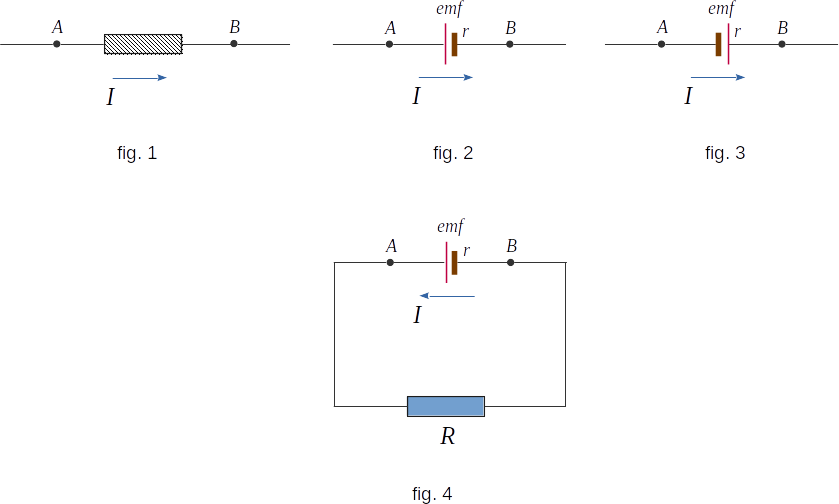From the Direct electric current
99. Joule-Lenz law for the section of circuit containing EMF
Arbitrary circuit section.
Let us consider an arbitrary circuit section \(AB\) (fig. 1). Here \(V_a ~\) is the potential of point \(A\), and \(V_b ~\) is the potential of point \(B\). Since \(\Delta{V_{ab}} ~\) is always equal to the work on moving a single positive charge from \(A\) to \(B\), then regardless of what is included in this section (galvanic elements, batteries, electric motors, generators, etc.), the equations for work and power\( W \,= \,I\,\,\Delta{V_{ab}}\,t, ~~ \,P_e \,= \,I\,\,\Delta{V_{ab}} \) (9-15)
obtained in \(\S \,95\) remain valid. To get these equations, only the determination of the potential difference and the energy conservation law were used. However, equations for determining the power
\( P_e \,= \,I^2\,R \,= \,\frac{(\Delta{V_{ab}})^2}{R} \)
and similar equations for work will not be valid if the section \(AB\) contains EMF. In this case, the Ohm's law in form \((9-4)\) is not applicable.
So, the initial formula for the electric current power in general is equation \((9-15)\). First of all, let us pay attention to the fact that the power can be both positive and negative. If there is an EMF in the section, then electric current can flow from a point with a smaller potential to a point with a higher potential (\(V_a \,< \,V_b \,\) and \(\,P_e \,< \,0\)). This is the case for the \(AB\) circuit section, which is shown in figure 4. For a circuit section without EMF \(~ V_a \,> \,V_b \,\) and \(\,P_e \,> \,0\). In this case, as it was found out in \(\S \,95\), the section absorbs energy from the circuit and emits it as heat. Therefore, one should expect that at \(P \,< \,0 ~\) the section emits energy, which then enters into the circuit. Soon we will see that this is the case.
Charging the battery.
At the beginning we will consider a case when the electric current at section \(AB ~\) is directed against EMF (charging of the accumulator, fig. 2). Let the current force be equal to \(I\), EMF is equal to \(\mathcal{E}\), and the resistance of the section \(r\). According to Ohm's law \((9-14)\) in this case\( V_{\oplus} \,- \,V_{\ominus} \,= \,V_a \,- \,V_b \,= \,\Delta{V_{ab}} \,= \,\mathcal{E} \,+ \,I\,r\) (9-16)
or
\( I \,= \,\frac{\Delta{V_{ab}} \,- \,\mathcal{E} }{r}\) (9-17)
Substituting in the basic equation for power \((9-15)\) once the value of \(\Delta{V_{ab}} ~\) from (\(9-16\)), and another time \(I ~\) from (\(9-17)\), we will get three equivalent expressions for power in this case
\( P_e \,= \,I\,\Delta{V_{ab}} \,= \,I\mathcal{E} \,+ \,I^2\,r \,= \,\frac{(\Delta{V_{ab}})^2 \,- \,\mathcal{E}\Delta{V_{ab}}}{r}\) (9-18)
Since \(\Delta{V_{ab}} \,> \,\mathcal{E}\), then \(P_e \,> \,0\). The \(AB\) section borrows energy from the circuit. What does this energy do? This can be seen from the equation
\( P_e \,= \,I\mathcal{E} \,+ \,I^2\,r \)
The value of \(I^2\,r ~\) is the part of the power absorbed by the section, which is used to generate heat. At \(\,\mathcal{E} \,= \,0 ~\) \(P \,= \,I^2\,r\). The other value of \(I\mathcal{E} ~\) is the work per unit of time performed when moving the charges in the direction opposite to the direction of the external forces of the battery. This is the power consumed when charging the battery to increase its chemical energy.

Discharging the battery.
Now let's consider another case, when the electric current is directed along EMF (fig. 3).The power is still determined by the equation \((9-15)\). But Ohm's law now looks differently
\( V_{\ominus} \,- \,V_{\oplus} \,= \,V_b \,- \,V_a \,= \,-(\,V_a \,- \,V_b) \,= \,\Delta{V_{ba}} \,= \,-\Delta{V_{ab}} \,= \,\mathcal{E} \,- \,I\,r\) (9-19)
or
\( I \,= \,\frac{\mathcal{E} \,- \,\Delta{V_{ba}} }{r}\) (9-20)
It is more convenient to enter the potential difference \(V_b \,- \,V_a~\) instead of \(V_a \,- \,V_b ~\), because \(V_b \,> \,V_a ~\). By substituting again in the equation \((9-15)\) first the difference of potentials \((9-19)\) and then the electric current \((9-20)\), we obtain all possible expressions for power in the considered case
\( P_e \,= \,I\,\Delta{V_{ba}} \,= \,-I\,\Delta{V_{ab}} \,= \,I^2\,r \,- \,I\mathcal{E} \,= \,\frac{(\Delta{V_{ba}})^2 \,- \,\mathcal{E}\Delta{V_{ba}}}{r}\) (9-21)
Now \(P \,< \,0 ~\). Consequently, the section as a whole sends energy into the circuit. The product of \(I\mathcal{E} ~\) is the energy released by the battery in a unit of time. Part of this energy, equal to \(\,I^2\,r \,\), is absorbed in the section itself and is emitted as heat.
Closed circuit.
For closed circuit (figure 4)\( P_e \,= \,I\,\mathcal{E}\) (9-22)
And \(\,I\,\mathcal{E} ~\) - the quantity of energy coming from an electric current source into the circuit per unit of time, and at the same time it is that energy, which is emitted by electric current in the form of heat.
It should be emphasized that equations \((9-18)\), \((9-21)\) and \((9-22)\) represent energy relations completely independent of nature in the considered circuit section or in the whole closed circuit.